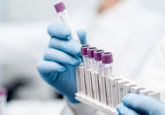The best of biosensors and biopsies in bioanalysis

- Real time oxygen monitoring in organ-on-a-chip systems is made possible with novel biosensor
- Blood test could predict long term success of treatment for diffuse large B cell lymphoma patients within days of starting therapy
Real time oxygen monitoring in organ-on-a-chip systems is made possible with novel biosensor
Georgi Makin (Future Science Group)
A biosensor has been developed by a team of researchers from North Carolina State University and University of North Carolina (NC, US), which is capable of tracking oxygen levels in organ-on-a-chip systems in real time.
The sensor allows researchers to monitor the system, retrieve data effectively and ensure that the system closely mimics the function of the real organ, which is essential for potential applications of organ-on-a-chip systems in high-throughput pharmacological and toxicity testing.
“For the most part, the only existing ways of collecting data on what’s happening in an organ-on-a-chip are to conduct a bioassay, histology, or use some other technique that involves destroying the tissue,” explained Michael Daniele (North Carolina State University and University of North Carolina).
“What we really need are tools that provide a means to collect data in real time without affecting the system’s operation,” Daniele continued. “That would enable us to collect and analyze data continuously, and offer richer insights into what’s going on. Our new biosensor does exactly that, at least for oxygen levels.”
The sensor works by measuring lag times between the exposure of a phosphorescent gel to an infrared light, and an echoing flash. The time between exposure and the subsequent emission of infrared light by the gel depends on the amount of oxygen in the environment. Therefore, researchers are able to monitor the presence of oxygen with lag times measured in microseconds.
The more oxygen present in the environment, the shorter the lag time.
At present, the biosensor has been successful in three-dimensional scaffolds utilizing breast epithelial cells.
“One of our next steps is to incorporate the biosensor into a system that automatically makes adjustments to maintain the desired oxygen concentration in the organ-on-a-chip. We’re also hoping to work with other tissue engineering researchers and industry. We think our biosensor could be a valuable instrument for helping to advance the development of organs-on-a-chip as viable research tools,” Daniele concluded.
Sources: Rivera KR, Pozdin VA, Young AT, Erb PD, Wisniewski NA, Magness ST, Daniele M. Integrated phosphorescence-based photonic biosensor (iPOB) for monitoring oxygen levels in 3D cell culture systems. doi: https://doi.org/10.1016/j.bios.2018.07.035 (Epub ahead of print) (2018); www.sciencedaily.com/releases/2018/08/180820150147.htm
♦
Blood test could predict long term success of treatment for diffuse large B cell lymphoma patients within days of starting therapy
Researchers from the Stanford University School of Medicine (CA, USA) have recently published results of a novel blood test that may be able to predict how patients with diffuse large B cell lymphoma are responding to therapy within days of treatment being administered. The test can then potentially predict whether patients would benefit from more aggressive treatment within days or weeks of beginning therapy, instead of previously having to wait up to six months for treatment to be complete.
In the study, published recently in Journal of Clinical Oncology, the researchers monitored ctDNA levels in 217 people being treated for large B cell lymphoma at six medical centers across the USA and Europe. For each patient, they compared the levels of circulating tumor DNA (ctDNA) from before treatment began with their levels after the first and second round of conventional chemotherapy. The team reported that ctDNA was detectable prior to the initiation of therapy in 98% of the patients participating. As predicted, the amount of ctDNA in the blood declined in all patients once treatment began. However, the rate of the decline varied between patients. Patients whose ctDNA levels dropped a hundredfold after the first round, or three-hundredfold by the second round, were much more likely to live 24 months or more without experiencing a recurrence of their disease, when compared to those whose ctDNA levels declined more slowly.
David Kurts (Stanford University School of Medicine), senior author of the article, explained: “We found that ctDNA levels serve as a very sensitive and specific biomarker of response to therapy within as few as 21 days. Every year, about 30,000 people in the United States are diagnosed with diffuse large B cell lymphoma and, for the most part, they’re treated with six cycles of combination therapy. But we know that not all patients need six cycles. A large fraction could be cured with fewer cycles- maybe even just two. If we can identify those people who are responding extremely well, we could spare them additional treatments. Conversely, we could intensify the therapy or seek other options for those who are not responding as well as we would have hoped.”
The team is encouraged by the consistency of their results across the six medical centers, thus potentially suggesting the global usefulness of the analysis. They have also reported they are planning a clinical trial based on their results for the future.
Sources: Kurtz DM, Scherer F, Jin MC et al. Circulating Tumor DNA Measurements As Early Outcome Predictors in Diffuse Large B-Cell Lymphoma. J. Clin. Oncol. doi: 10.1200/JCO.2018.78.5246 (Epub ahead of print) (2018); http://med.stanford.edu/news/all-news/2018/08/liquid-biopsy-predicts-lymphoma-therapy-success-within-days.html





